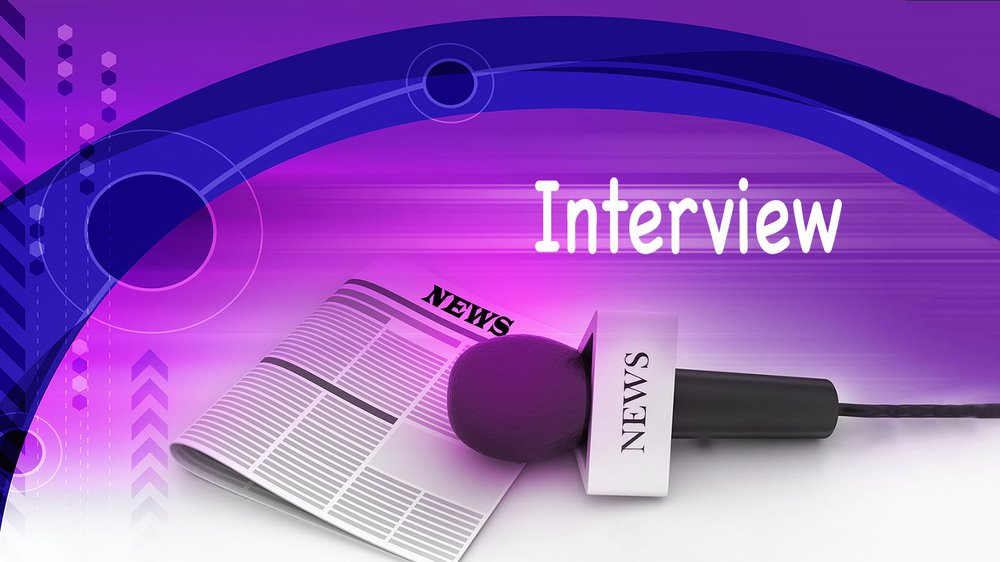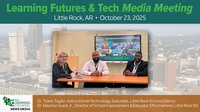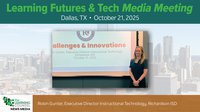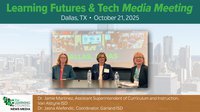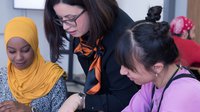The Learning Counsel caught up with Traci Bonde, Chief Technology Officer for the Dublin Unified School District in the San Francisco Bay Area, to chat about EdTech, blended learning and how her role has developed over the years. Bonde has worked in education and technology for 17+ years and has first-hand experience in how education is evolving regarding EdTech. Bonde shared her poignant perspectives and spoke about how she sees education changing. She is involved in the Maker Movement and foresees the blending of low or no tech Maker activities with modern digital tools to be seen more prevalently in the future of education.
Learning Counsel: Could you share how you've seen your role developing regarding the prevalence of digital tools?
Bonde: When I started way back in the early 1990's, technology was a luxury in schools and it was not critical to the learning objectives. Over time, it became more of an add-on. The real shift occurred at the influx of Common Core high stakes testing that was mandated across the country and computer based.
At that point, around 2014, these early conversations started at Departments of Education all over the country. California was a prime example. We began this conversation early, around 2012, and that began pushing districts to start thinking about technology, and teachers that had been primarily reluctant to using technology in classrooms, to use computer labs. Now all of this is way before mobile devices and Chromebooks. They began understanding that because of the push towards online testing they would have to begin focusing some effort and time on technology skills, keyboarding, navigating screens, interacting with audio. With those early conversations began the need for technology leaders to not just plan out infrastructure and internet, but sit at the table with Curriculum Leaders, to see how, together, we can accomplish goals.
That’s been the real shift. It wasn't an internal grassroots effort. It really came by way of a mandate. And that's been my experience, and I've seen how that's played out. Back in 2012 and 2013, I used to go and work with classroom teachers, and they didn't have a rationale for using technology, and they definitely weren't being pressed. Fast forward now to 2018 and they can't not use technology in almost every subject and almost every grade level. It has become more than just a part of their productivity, because of email and things like Google Suite, online file transfers, and portals for entering grades. All of those things have had a slow evolution, but the real shift that we're seeing speed up is that connection of student technology used in classrooms, still in pockets, but becoming more common than not.
Learning Counsel: What sort of digital tools are you finding to be your favorites?
Bonde: I am an enormous fan of Chromebooks right now because they are inexpensive from a budget perspective, super easy to manage from an IT perspective, and literally nothing can go wrong with a Chromebook in a classroom as long as you have internet. The teacher and or the student presses a button, operating system boots up, if something’s not working it restarts. That very simplistic operating system has been an absolute game changer in classrooms. You can take the Chromebook operating system, Chrome, and you can drop it on old computer technology, for example old MacBooks, so it's not that you need to have a Chromebook.
I would say that in the Chromebook model we've seen, the operating system is an absolute design champion for classrooms, because it takes away excuses. You don't have to worry about plug-ins or it's going to run updates in the middle of a lesson, it's not going to automatically shut off, because if something’s broke it reboots. Those things are really significant. That device, and access to video content, consumption and creation, for me are the most exciting tools to hit the classrooms. The students, now when they're not at school, are generating video at exponential rates, and they're consuming YouTube in ways that I don't think even YouTube ever anticipated. If we can take that same passion for video and bring it to the classroom, which is what my focus area is, I think that's got great potential, and it's a real hook for teachers across every subject to empower their students to demonstrate their learning.
Learning Counsel: Are you currently using any video editing applications with students?
Bonde: We have pockets of subscriptions to Flipgrid, we've not gone district-wide yet in Dublin. We've got pockets of Screencastify extensions, WeVideo free versions, and what I've really pushed, although our teachers don't love it, is the YouTube editor, because it's embedded in YouTube, and because it's part of the Google Suite. I think it's very easy overall. A little clunky, but a lot of our teachers didn't even realize when we first started pushing video last year that the YouTube editor has many of the same goodies, and it's built in. Our students have access to YouTube, so they can have a YouTube channel, they can import and edit on the fly, and then they can post, either privately or publicly depending on their age level and goal. So YouTube video is really, I think, a little under-utilized and something we really push in Dublin.
Learning Counsel: From an administration standpoint, is your district using management software or analytics applications that you're finding to be useful and effective?
Bonde: We do not have a learning management system. We don't have anything like BrightBytes yet. We have a new data warehouse this year that houses formative, local and summative assessments, all in one interface that's robust K-12. The area that I think our administrators are really starting to excel at is in using video conferencing with Google Hangouts for real-time communication across the district. That has become very common for meetings, and that's something that has been a real win for administrators that don't want to spend 20 minutes driving to a 30 minute meeting to then spend 20 minutes driving back. We've enabled a lot of those tools that have really made administrators far more efficient.
Learning Counsel: Do you have a vision of where we are heading in general and where you'd like to see your district going in regard to digital tools and blended learning?
Bonde: I think that the shift we're going to make in the next five years is re-invigorating the non-tech Maker Model. We used to call them hobbies. I see a lot of hands-on education using different tools, and no tech. I think that marriage of the low-tech exposure, using cardboard and tape, plastic, PVC, and recyclable materials, connected with online education and augmented reality, is really going to start to take off.
For example, you'll be sitting in a second grade classroom and you'll have an assignment where you might be constructing something with cardboard first, and then you'll pick up your augmented reality tools, and you'll take that cardboard 3-D prototype into another environment where you'll build it out with a variety of tools, much like you see examples of doctors that are doing it with heart surgery. Translate that down to a second grade classroom. Second graders will be doing that same thing, but they'll be using good old-fashioned paper, glue, cardboard and tape, and they'll construct their design, and then they will take it into the world. They might be collaborating with kids across the county, across the district, in a portal to be invented because it's not there yet, but it's coming real soon.
That will be, I think, is where our classrooms will be. So, when I say online education I don't mean our students taking pure online courses, because that ship has sailed, and it's not proven to be highly useful, but they'll actually be engaged in online environments with other kids and interacting with the physical, and virtual worlds in new ways.
I would see that as blended learning. Not the, "Oh I'll watch the video at home and then tomorrow we’ll talk about it in class.” That's what blended learning was five years ago and I don't see that as true blended learning.
Learning Counsel: How do you feel about personalized learning applications? Do you think there's going to be a lot of growth in that through A.I.?
Bonde: I think we're at early stages, so I would say “to be determined” on how that will really play out. I think the potential for personalized learning around meeting the individual needs of a given student throughout the day, or after hours, or 24/7 learning, to utilize a variety of tools like they do now in their personal lives to achieve their goals. When they can do that during the school day, it'll be really powerful.
As an example, my 12-year-old son, who is a techie himself, will engage in an online game on one device while he's chatting with a friend on another device, and then he's doing research on YouTube on a third device, and it's all tied to the game. The communication piece on one device, the researching and YouTube on another device, and then the actual gameplay on another device. That's my son approaching a problem, solving a problem with three different devices. I see that as really where personalized learning needs to go, and I think that right now a lot of us are missing that, because we're not paying attention to how our students, a.k.a. our children, use the tools.
Here's a great example. You'll walk into a library at a high school, and the students will have access to Chromebooks to type their papers. But you'll see examples of students typing their papers in Google Docs with their phones, and then you'll see another set of students typing their papers on their phones using Google Voice typing. Now, we've got the Chromebooks, and a teacher would say, or a librarian would say, "Why don't you just type on the Chromebook, because that's what I do". But our students are more inventive than that and we don't see that translation as seamlessly as the student does. They're not tied up with hardware, when they need to achieve a goal, sitting in front of a computer may not be the most efficient tool for them.
Now, we're still trying to figure out, “What does personalized learning look like?” People are trying to build out these portals and as you advance in the game you choose A or B it will take you another place. I think that's another silver bullet potential solution that is going to fall flat.
You might walk into a high school science class, and there could be four or five different device types available to accommodate the same objective, allowing the student ultimate flexibility about how they achieve their goal. That's personalized learning for me, and like you pointed out, we're hearing so many people talk about, "Well, you know, we're going to build out these new environments and it's going to be totally personalized", and I just don't know that that's going to translate to the real classroom environment. We are still going to need to provide for students every day in their classes, in brick and mortar buildings. Those brick and mortar buildings are not going away, but they’re going to look different we hope.
Learning Counsel: What are some of the bigger challenges you're seeing come up when it comes to implementing this technological redesign and methodology?
Bonde: A current trend that I see in the Bay Area is; we're infused with the Maker Movement, and we're infused with direct access to high technology companies, in ways that other parts of the world are not, because of our location geographically. I think what I have been seeing for 15 plus years is we are trying too hard to solve a simple problem. We believe that more and bigger is better, so we're going to buy more technology, and we're going to make access bigger.
Here's an example. Let’s say I'm a passionate elementary school principal and I want a makerspace in my library because I've heard the buzz, everybody's doing makerspaces, so I go out and I secure funds, and I build a budget, and I buy three 3D printers and I buy a laser cutter, and I buy all of these Lego design kits so that the kids will be really interactive. And then I put it all in there, and I invite the kids in, and now what? And then the bigger question is, so what?
If I approached that same makerspace and just went to a really simplistic view, no tech, or low tech, created opportunities and spaces where the kids could gather and create, I think that would be far more beneficial. But by the sheer nature of the industry that we are in, we always believe that we have to do more, and it has to be bigger. I believe we're missing a lot of very simple solutions, because we're overdoing it all the time.
Learning Counsel: A few weeks ago, we had a great conversation with Doug Robertson, who teaches in Portland. He spoke about creating cardboard games with students and how the students were having a lot of fun and really involved in that process. The games were like the ones created by Caine Monroy in the Caine’s Arcade video on YouTube. Have you done this in class?
Bonde: We did that in the Spring at one of our elementary schools. The fifth-grade team dedicated a whole week, and they brought in supplies, cardboard, tape, and pens, and they let the kids work in teams. At first, they struggled, and they failed, but by the end of the week they had built a full-blown carnival. Younger grades came through and played the games, but the process was what was really exciting, and there was zero tech.
Learning Counsel: That sounds like it would be very engaging and effective; blending some of the functions of technology with more hands-on stuff.
Bonde: Yes. When I'm getting calls or having conversations with people throughout the state that are thinking about makerspaces, I really encourage them. Year one, go no tech, and maybe a little bit of low tech. Then decide through that first year whether you're going to invest in any high tech. What's the purpose, who's the audience, and how is it going to be used? Then the other piece is who is going to manage, maintain and repair it? But I think going that route is going to be far more successful than loading a lot of high tech goodies into a room, hoping that students will come. Because they won't.
Learning Counsel: You recently attended the East Bay Mini Maker Faire in Oakland, CA. What were some of your favorite projects that you saw there?
Bonde: Over the course of the last five years I have attended, the hands-on workshops and displays are definitely standouts. They have a make-your-own-butter machine, and it's literally baby jars with heavy cream and you shake it for a couple of minutes worth of physical labor, and then you end up making butter. It really is empowering for the kids to see that process, and to have been able to do that. So that's been a standout. They have a waterway that they also build every year, these little tubular water tunnels and these kids and adults will build floating devices that they then have to try to run the course. They can decorate the floating device, but really what they're going for is proof of concept, so it's a great hands-on example with a lot of potential for failure, but I think are great opportunities, so those would be my two favorites at the Mini Maker Faire.
Learning Counsel: On your blog you posted a new article about EdTech tools Scratch and Makey Makey, it looked really neat. Could you tell us more about those projects?
Bonde: I attended training a year ago to become Makey Makey certified with four of my department staff. We saw an opportunity the minute we started learning and using the Makey Makey, which is like a $30 to $50-dollar device that you can buy on Amazon or direct for Special Education, mild to mod, mod to severe physically handicapped community.
What we started doing was building capacity right away. We had conversations with the SPED department and started doing some trainings within our own group with EdTech coaches. With Special Ed teachers around this powerful tool it takes your keyboard into the physical environment and essentially turns anything that's conductive into a keyboard. For a student that schools spend $150 dollars on a special button mouse that's larger and visually appealing, we can do the same project for that student in their classroom, for pennies on the dollar, with recycled materials that are built by students, managed by students, and then utilized and customized for the student. So, that's been a focus and my department has been really working and partnering with our Special Education teachers and specialists.
Learning Counsel: While reading your blog it looks like your department turned a coffee cup and a guitar into digital devices with Makey Makey and Scratch.
Bonde: We did some eye candy projects just to spur imagination, and a couple of passion projects, because I've got some hot shots in my department. One of the projects that I think the team is most proud of is what we've done with the Special Education Department and then also for stress management at our high school. Utilizing a tool like Scratch that's totally customizable and very robust, and a Makey Makey. We actually built what's called an “affirmation station”. So, a kid at the high school that's having a rough day, stressed out, can go to this wall, touch their button, and they'll get a positive affirmation from one of their favorite teachers.
**
Traci Bonde is an impassioned CTO who goes above and beyond to carefully consider instructional methodologies and curriculum in her work. She is exemplary of the modern Chief Technology Officer and is working to ensure students are receiving the best education possible. If you would like to stay up to date with her work, check out her blog Making Makers in Edu and find her on Twitter @tr_bo.

